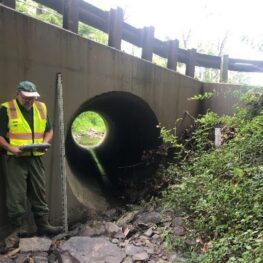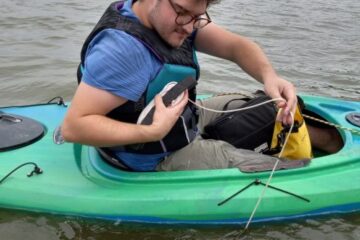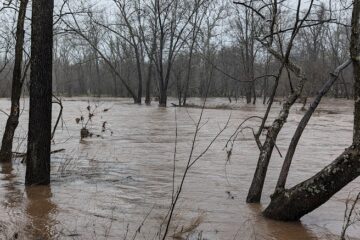
Ray Croot, RHA volunteer and NAACC Lead Observer assessing a stream culvert under a roadway in the Upper Raritan watershed.
For people, traveling from place to place often means driving on roadways and in the process crossing over streams and rivers. Within the 470-square-mile upper Raritan River watershed in Hunterdon, Somerset and Morris counties, there are thousands of places where roads cross waterways via structures ranging from high bridges to narrow culverts.
Do individual bridges and culverts allow fish and wildlife the ability to safely and effectively cross under roadways? Is the bridge or culvert functioning well and allowing the movement of water during major storms when flooding becomes an issue?
These are some of the questions Raritan Headwaters Association (RHA), a nonprofit conservation organization based in Bedminster, is working to find out by assessing conditions at 150 stream crossings with funding from NJ Department of Environmental Protection’s Endangered and Nongame Species Program (ENSP).
ENSP’s mission is to conserve biological diversity by maintaining and enhancing rare wildlife populations within healthy, functioning ecosystems. New Jersey’s endangered and threatened species include bobcats, bog and wood turtles, and several salamander and snake species. “We have an opportunity to identify culverts and bridges that need upgrading so that the stream is connected on both sides of the road and fish can move upstream and downstream. As an added bonus, if the crossings meet certain criteria such as presence of dry passage, they may also aid the movement of reptiles, amphibians and mammals under roadways, reducing roadkill,” said Dr. Kristi MacDonald, RHA’s science director.
Lack of Connectivity
The stream connectivity assessment project began in August 2021 and is now nearly completed, with RHA staff and volunteers evaluating the final 25 stream crossings this fall. Each crossing was scored to indicate how much of a barrier it poses to wildlife movement.
“Unfortunately, a lot of our culverts do not provide the connectivity needed, especially for terrestrial wildlife” said Dr. MacDonald.
Dr. MacDonald explained that many culverts consist of pipes of varying widths that carry water underneath roads. Many culvert pipes are too small to make suitable travel corridors for large mammals – or even smaller animals that don’t like to get their feet wet.
As a result, a lot of animals are killed as they try to cross busy roadways. It is estimated that about 365 million animals are killed by collisions with vehicles on roadways every year in the United States.
Some culvert pipes, she added, don’t provide connectivity for fish and other aquatic creatures. For example, the RHA study found many “perched pipes” where water pours like a waterfall into a scoured-out pool instead of flowing at a level elevation. These conditions don’t allow fish and macroinvertebrates to travel in both directions, hindering their reproduction.
In addition, tree branches, sediment and other debris often get stuck in poorly designed or outdated culvert pipes, creating clogs. “As we get more frequent and extreme storm events with climate change, functioning culverts will be a priority for preventing flooding and protecting road integrity and property,” she said.
Dr. MacDonald said the study will be used to guide state environmental and government agencies, as well as local municipalities, on upgrading culverts and other stream crossings to allow for stream connectivity, safe passage for wildlife, and climate resilience.
“I’m excited about the potential to protect fish and wildlife populations using the data we are gathering,” she said. “Biodiversity is declining globally and if we can make small changes to ensure streams are connected and that animals can safely cross roadways, then we need to do it.”
Bedminster Turtle Tunnels
We know wildlife will use under-road tunnels from studies done of wildlife crossing projects built in several locations in New Jersey and elsewhere.
For example, five “turtle tunnels” were completed by ENSP in Bedminster in 2015, the first of their kind in the state. The tunnels go under River Road, which separates the North Branch Raritan River from hundreds of acres of natural areas and parkland.
The project includes special fencing to guide creatures into the tunnels. The tunnels help wood turtles move from hibernating areas in wetlands along the river to spring breeding grounds on the other side of the road. Follow-up studies show they’re also helping other species cross the road safely, including snakes, frogs, toads, salamanders, newts, box turtles, raccoons, foxes, moles, and voles.
To choose the stream crossings to be assessed in the current study, Raritan Headwaters used maps from the North Atlantic Aquatic Connectivity Consortium (NAACC) and a statewide wildlife project called Connecting Habitat Across New Jersey (CHANJ). The goal of CHANJ is to focus protection on core habitat areas and to connect these areas with narrow habitat corridors so that wildlife can move more easily in the landscape.
From the initial map of 477 stream-road crossings in the Upper Raritan River watershed, 150 were selected as top priorities for assessment. So far, about 29% of the assessed structures present a significant barrier to movement of fish and other aquatic wildlife but 84% were significant barriers to terrestrial wildlife movement under roadways.
Rita Matos, RHA’s former Stream Connectivity Coordinator and North Atlantic Aquatic Connectivity Collaborative (NAACC) L1 Coordinator, RHA volunteers Ray Croot (NAACC Lead Observer) and Brian Lynch, and RHA interns Shannen Higgins and Madison Purguy devoted many hours to training in NAACC protocols and assisting in data collection.



